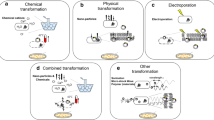Abstract
A practical random mutagenesis system of Ralstonia solanacearum by electroporation with Tn5 transposon was established, which may be utilized to provide genetic approach to study virulence genes of R. solanacearum strains and create nonpathogenic mutants for biological control of bacterial wilt in Pogostemon cablin. R. solanacearum strain PRS-84 used in this study was isolated from P. cablin plants infected with bacterial wilt. The bacterial suspension of R. solanacearum strain PRS-84 was mixed with Tn5 transposome complex and the mixture was transformed by electroporation. The electroporated cells were then spread on the 2, 3, 5-triphenyltetrazolium chloride agar plates containing kanamycin to select the kanamycin-resistant colonies. Several factors which determined the bacterial transformation efficiency were optimized. The transformation process was shown to be optimal at the electric field strength of 12.5 kV cm−1. Bacterial cells harvested at mid-exponential phase gave the highest transformation efficiency. 10 µg mL−1 kanamycin was found to be the optimal concentration for transformant selection. Tn5 insertion mutants of R. solanacearum strain PRS-84 were identified by PCR amplification and Southern blot analysis. Mutants subcultured for 100 passages were also detected by PCR amplification and Southern blot analysis. Furthermore, pathogenicity screening test of mutants was performed by inoculating in vitro regenerated patchouli plants. Results revealed that mutants with a single Tn5 insertion in their genomes were obtained from R. solanacearum strain PRS-84, and the Tn5 insertion could be stably inherited in the mutants. Then, mutants with reduced pathogenicity were selected.





Similar content being viewed by others
References
Bunrathep S, Lockwood GB, Songsak T et al (2006) Chemical constituents from leaves and cell cultures of Pogostemon cablin and use of precursor feeding to improve patchouli alcohol level. Sci Asia 32:293–296. https://doi.org/10.2306/scienceasia1513-1874.2006.32.293
Chaudhry V, Bhatia A, Bharti SK et al (2015) Metabolite profiling reveals abiotic stress tolerance in Tn5 mutant of Pseudomonas putida. PLoS ONE 10(1):e0113487
Couteaudier Y (1992) Competition for carbon in soil and rhizosphere, a mechanism involved in biological control of Fusarium wilts. In: Tjamos EC, Papavizas GC, Cook RJ (eds) Biological control of plant diseases. Springer, Boston, pp 99–104
Hayward AC (1991) Biology and epidemiology of bacterial wilt caused by Pseudomonas solanacearum. Annu Rev Phytopathol 29:65–87. https://doi.org/10.1146/annurev.py.29.090191.000433
Hoffman LM, Jendrisak JJ, Meis RJ et al (2000) Transposome insertional mutagenesis and direct sequencing of microbial genomes. Genetica 108(1):19–24. https://doi.org/10.1023/A:1004083307819
Jin H, Deng ZC, He H (2014) Effect of explant types and plant growth regulators on direct regeneration in medicinal plant Pogostemon cablin. Plant Omics 7(5):322–327
Kelman A (1954) The relationship of pathogenicity of Pseudomonas solanacearum to colony appearance in a tetrazolium medium. Phytopathol 44(12):693–695
Li JG, Dong YH (2013) Effect of a rock dust amendment on disease severity of tomato bacterial wilt. Antonie Van Leeuwenhoek 103(1):11–22. https://doi.org/10.1007/s10482-012-9781-4
Li YR, Che YZ, Zou HS et al (2011) Hpa2 is required by hrpF to translocate Xanthomonas oryzae TAL effectors into rice for pathogenicity. Appl Environ Microbiol 77(11):3809–3818
Lin YM, Chou IC, Wang JF et al (2008) Transposon mutagenesis reveals differential pathogenesis of Ralstonia solanacearum on tomato and Arabidopsis. Mol Plant Microbe Interact 21(9):1261–1270. https://doi.org/10.1094/MPMI-21-9-1261
Liu D, He H, Huang HB, Xie JH, Chai TT (2011) Isolation of pathogenic Ralstonia solanacearum from Pogostemon cablin and determination of its pathogenicity. Chin Tradit Herbal Drugs 42(8):1596–1599. (In Chinese)
Luo JY, Qiu W, Chen L et al (2015) Identification of pathogenicity-related genes in biofilm-defective Acidovorax citrulli by transposon Tn5 mutagenesis. Int J Mol Sci 16(12):28050–28062
Mahanta JJ, Chutia M, Sarma TC (2007) Study on weed flora and their influence on patchouli (Pogostemon cablin Benth.) oil and patchoulol. J Plant Sci 2(1):96–101
Nakaune M, Tsukazawa K, Uga H et al (2012) Low sodium chloride priming increases seedling vigor and stress tolerance to Ralstonia solanacearum in tomato. Plant Biotechnol 29(29):9–18
Ramya HG, Palanimuthu V, Rachna S (2013) An introduction to patchouli (Pogostemon cablin Benth.)-A medicinal and aromatic plant: it’s importance to mankind. Agric Eng Int 15(2):243–250
Ray SK, Kumar R, Peeters N et al (2015) rpoN1, but not rpoN2, is required for twitching motility, natural competence, growth on nitrate, and virulence of Ralstonia solanacearum. Front Microbiol 6:229. https://doi.org/10.3389/fmicb.2015.00229
Rygulla W, Snowdon RJ, Eynck C et al (2007) Broadening the genetic basis of Verticillium longisporum resistance in Brassica napus by interspecific hybridization. Phytopathology 97(11):1391–1396. https://doi.org/10.1094/PHYTO-97-11-1391
Sambrook J, Russell DW (2001) Molecular cloning: a laboratory manual, 3rd edn. Cold Spring Harbor Laboratory Press, Cold Spring Harbor
Scherf JM, Milling A, Allen C (2010) Moderate temperature fluctuations rapidly reduce the viability of Ralstonia solanacearum race 3, biovar 2, in infected geranium, tomato, and potato plants. Appl Environ Microbiol 76(21):7061–7067. https://doi.org/10.1128/AEM.01580-10
Singh M, Rao RSG (2009) Influence of sources and doses of N and K on herbage, oil yield and nutrient uptake of patchouli [Pogostemon cablin (Blanco) Benth.] in semi-arid tropics. Ind Crop Prod 29(1):229–234. https://doi.org/10.1016/j.indcrop.2008.05.005
Song X, Guo J, Ma WX et al (2015) Identification of seven novel virulence genes from Xanthomonas citri subsp. citri by Tn5-based random mutagenesis. J Microbiol 53(5):330–336. https://doi.org/10.1007/s12275-015-4589-3
Titarenko E, López-solanilla E, García-olmedo F et al (1997) Mutants of Ralstonia (Pseudomonas) solanacearum sensitive to antimicrobial peptides are altered in their lipopolysaccharide structure and are avirulent in tobacco. J Bacteriol 179(21):6699–6704
Acknowledgements
This work was supported by grants from the National Natural Science Foundation of China (No. 81373901) and Ph.D. Programs Foundation of Ministry of Education of China (No. 20134425110012).
Author information
Authors and Affiliations
Corresponding author
Ethics declarations
Conflict of interest
The authors declare that they have no conflict of interest.
Rights and permissions
About this article
Cite this article
Wang, Y., Zhang, Y., Jin, H. et al. A practical random mutagenesis system for Ralstonia solanacearum strains causing bacterial wilt of Pogostemon cablin using Tn5 transposon. World J Microbiol Biotechnol 35, 7 (2019). https://doi.org/10.1007/s11274-018-2581-x
Received:
Accepted:
Published:
DOI: https://doi.org/10.1007/s11274-018-2581-x




